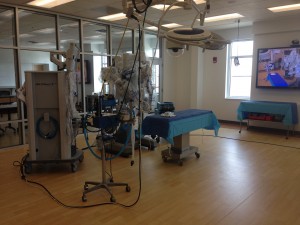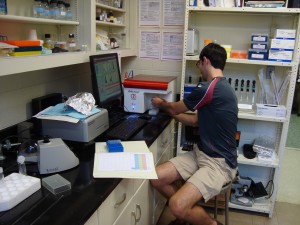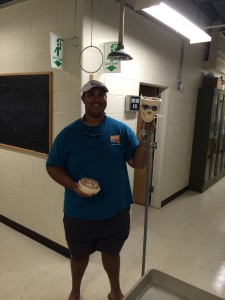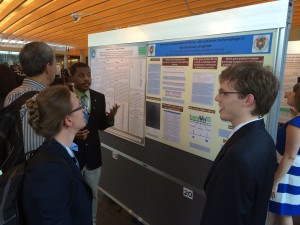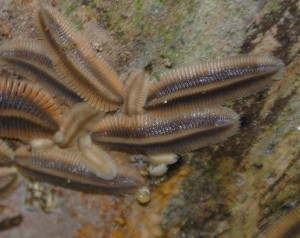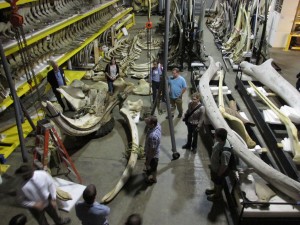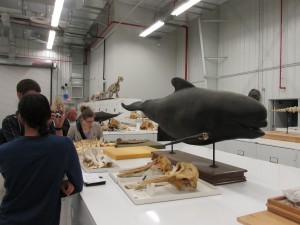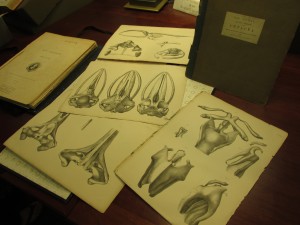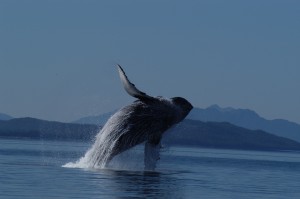Drake Bishop, a recent graduate in H-SC’s Class of 2014, has been selected as the recipient of the 2014 Dorothy Middleton Memorial Scholarship at Eastern Virginia Medical School. This prestigious award is given to one student from each year’s entering class of medical school and provides a full scholarship that is renewable for all 4 years of medical school. Since its establishment in 2011, two H-SC students have received the award (Barron Frazier ’12 was the recipient in 2012). Drake, a biology major and Summa Cum Laude graduate with Departmental Honors at H-SC, received the Samual S. Jones Phi Beta Kappa Award for Excellence in Research for his Senior Honors Project on melanoma-associated suppression of dendritic cells. Since graduating, Drake has been a participant in the Children’s Hospital of the King’s Daughters Summer Scholar Program at Eastern Virginia Medical School, where he has conducted research in the laboratory of Dr. Amy Tang on regulation of the K-RAS signaling pathway in lung cancer. He will begin his first year of medical school at EVMS this fall!
Author Archives: admin
A summer internship in reproductive medicine
by Travis Goodloe ’16
I have a summer research internship at the Center for Reproductive Medicine here in Mobile working with Dr. George Koulianos, MD and Dr. Suzanne Degelos, Ph.D. The Center specializes in many facets of reproductive medicine including several methods of in vitro fertilization as well as intrauterine insemination (IUI) in addition to general reproductive healthcare for couples and patients facing reproductive difficulties or infertility. My internship involves working as a lab tech with lab director Dr. Degelos by assisting in egg retrieval and embryo transfer procedures along with intracytoplasmic sperm injection (ICSI), which is the method used to fertilize eggs in vitro in the lab. Along with my lab tech responsibilities, I have been given my own project involving some data analysis and bioinformatics in order to help the Center publish an abstract that they have been trying to get out for several months now.
In the IVF world, a new technology known as physiological intracytoplasmic sperm injection (PICSI) has emerged since about 2012 which utilizes a special dish coated in media containing the protein hyaluronan. All normal morphological and functional sperm have hyaluronan binding receptors on their heads while eggs possess hyaluronan protein on their outer surface that bind during natural fertilization. Thus, PICSI dishes possess hyaluronan that allows for sperm binding in the dish and thus an embroylogist to select the best quality sperm for injection. My project has included analyzing all the patient records since 2012 when PICSI was first used here at the Center and comparing pregnancy outcomes to ICSI patients from the same time period. Many fertility clinics across the country are moving to this new method but unfortunately the sample size here at the Center as well as in other studies from around the country are not large enough to produce statistically significant results that prove PICSI is more effective and provides higher clinical pregnancy rates and more importantly successful delivery rates than standard ICSI.
To learn more about the science behind my project, check out http://www.ncbi.nlm.nih.gov/pmc/articles/PMC3545641/
An H-SC student heart surgery internship with an H-SC alumnus
by Evan Harris ’16
I am currently participating in a six week summer internship with the East Carolina Heart Institute under the supervision of Dr. W. Randolph Chitwood ’72, the founder and director of the Institute. Aaron Gilani ’15 will work with Dr. Chitwood in July. In this internship, I observe and shadow Dr. Chitwood and several other doctors who work under him or alongside him. Whether it’s through clinics, labs, or OR cases, I am directly exposed to the everyday work of thoracic surgeons, cardiovascular surgeons, and other physicians who deal with thoracic issues. I witness open heart valve repair/replacement surgery, robot assisted minimally invasive valve repair/replacement surgery, and other thoracic surgeries. This internship allows students to catch surgeons in action while asking questions regarding anatomy, physiology, or just the everyday struggles and rewards of being a physician. I recommend that any student with an interest in pursuing a career in medicine should apply for this amazing opportunity. Dr. Chitwood and his staff love to teach students, and Dr. Chitwood loves his alma mater, Hampden-Sydney College.
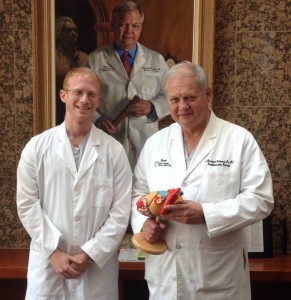
Alumni connections: Evan Harris ’16 with Dr. W. Randolph Chitwood ’72, founder and director of the East Carolina Heart Institute
Jay Brandt ’15 Conducting Cancer Research at H-SC
Rising senior Biology major Jay Brandt has been hard at work this summer conducting cancer research in collaboration with Elliott Assistant Professor of Biology Dr. Kristian M. Hargadon ’01. Through funding from the Virginia Foundation for Independent Colleges and the Hampden-Sydney College Honors Council, Jay has been investigating how melanoma-altered dendritic cells influence the quality of cytotoxic T cell activation. Using dendritic cells that have been isolated from the spleens of mice, Jay has utilized an ex vivo cell culture system in which dendritic cells whose maturation and activation have been modulated by melanoma-derived factors are used to stimulate naïve CD8+ T cells. Jay has then evaluated T cell activation using a variety of flow cytometric readouts that include CFSE-based T cell proliferation assays and intracellular cytokine staining assays. He is also in the process of conducting ELISAs to measure T cell production of the cytotoxin granzyme B. Collectively, these studies will provide significant insights into the induction of anti-tumor immune responses. Jay will be attending medical school following his graduation in 2015, and he has already been accepted to Eastern Virginia Medical School through the College’s Early Assurance Program with the medical school!
H-SC biologists/football players research helmets and concussions
Harold Willis ’16
This summer I am researching head and helmet impacts that can cause concussions in American Football (Football). Through a series of experiments I will obtain data on the intensity and location of head impacts an Offensive Lineman and Defensive Lineman may suffer. Once the analysis of the data is completed, I will be able to conclude which areas of an Offensive and Defensive lineman’s brain are most susceptible to trauma. Through the data I will monitor the frequency and intensity of impact on the areas of the brain that are most susceptible and then utilize that information to focus on protection for the areas of the brain affected. To obtain this data an accelerometer is enclosed inside a ballistic gel brain model and is used to collect the data needed for my study. This model gives me the ability to measure the intensity of the impact not only on the skull, but also on the brain. A drop test was conducted on a grass field from the average height of an offensive lineman (6’4”), and a defensive lineman (6’2”), in order to collect the intensity of impact through the accelerometers inside the brain. Once the data was collected, I placed the skull model on a variety of different helmets and ran the same experiment. This data will reveal which helmet type is best to protect the brain. From this data I will understand the susceptible areas of the brain. Later on, I hope to create a prototype for a helmet that protects Offensive and Defensive lineman from concussion brain trauma. As a college football player I am learning ways to extend my career in football and understanding how to protect football players from sport related injuries. I believe my research will impact the game of football and contribute to the protection other athletes can establish for themselves to prevent a possible concussion. I am passionate about the sport of football and envision these results helping me build a career in injury prevention. I foresee extending my focus of injury prevention to creating a helmet that protects all positions on the football field and then move to working on protection for other types of injuries that a football player or other types of athletes may sustain during their career.
Kyle Deivert ’16
This summer I have been researching head/helmet impacts in wide receivers and running backs. I have obtained data of intensity and location of head impacts for wide receivers (WRs) and running backs (RBs). After analysis of the data I have come to a conclusion of which areas of the brain are most vulnerable for each position: back, front, or side. The frequency and intensity of impacts to the specific areas of the head will determine the amount of focus on that area as far as methods of protection. After obtaining and analyzing this data I have set up the head/helmet testing. To obtain data for testing I have used accelerometers to measure intensity of impact and a synthesized ballistic gel to represent the brain in a skull model. Later in my research I hope to compare the effects of impact on different locations of an assortment of helmet brands to determine which helmets protect which areas of the brain more effectively. I have preformed dropped tests from an averaged height of 6 feet onto a grass field and collected data with the accelerometers inside the brains. I hope, at some point, to be able to move on to the design and construct new helmets for both RBs and WRs based on their more vulnerable locations of impact. As a collegiate football player I am very passionate about the sport and I am determined to achieve the best, most significant results. I hope to gather enough data to continue in the field of injury prevention and quite possible change the layout and construction of football helmets so players from youth to professional levels can play the game they love with less worry of receiving traumatic head injuries.
H-SC student researchers present their findings at the Howard Hughes Medical Institute
Joshua Dimmick ’15 and Grayland Godfrey ’15 represented Hampden-Sydney’s 2013-14 bacteriophage research class at the annual meeting of the Howard Hughes Medical Institute (HHMI) Science Education Alliance-Phage Hunters Advancing Genomics and Evolutionary Science (SEA-PHAGES) symposium. The SEA-PHAGES program unites ~80 institutions across the United States in the common goal of better understanding how bacteriophages have evolved over time (Learn more at http://www.hhmi.org/programs/science-education-alliance and http://www.phagesdb.org). The symposium was held at HHMI’s state of the art Janelia Farm Research campus in Ashburn, Virginia.
Josh and Grayland presented their genomic characterization of McFly, a bacteriophage of the bacterial species Mycobacterium smegmatis originally discovered on the H-SC campus in 2012 and named by Seth Ayers ’13, a past project participant. McFly resembles several bacteriophages isolated from across the U.S. but also has unique features such as the code for three tRNA molecules. By studying McFly along with the phages found at other schools, undergraduates like Josh and Grayland are contributing to authentic research spearheaded by a research group at the University of Pittsburgh that regularly disseminates findings through publication in peer-reviewed scientific journals.
Josh and Grayland received an Honorable Mention award at the end of the symposium, placing their poster presentation in the top 10 of over 70 student posted presented and placing them in the same tier as students from Johns Hopkins, Brown, and Carnegie-Mellon Universities. The SEA-PHAGES project will once again be in place at H-SC in the fall as a new group of biology students enrolled in Dr. Wolyniak’s Molecular and Cellular Biology course will attempt to isolate bacteriophage from the environment that target several species of the bacterial genus Bacillus.
Jaguars Ripped my Flesh
Dr. Shear has returned from the rain forest of Costa Rica, where he and the MITS team spent a week collecting millipedes at La Selva Biological Research Station, one of the facilities of the Organization for Tropical Studies. La Selva is located in lowland/piedmont rain forest on the Caribbean slope and provides facilities for researchers working on tropical ecology, systematics and evolution. While in Costa Rica, the team visited other preserves in Costa Rica, including Volcan Tenorio, near the Nicaragua border. The MITS project, financed by a NSF grant to Auburn University, Hampden-Sydney College, Virginia Tech and the Field Museum of Chicago will construct the first phylogenetic tree of millipedes using next-generation sequencing data. As many as 100 species will have their transcriptomes completely sequenced, giving us thousands of genes to work with. In addition, data on the chemical defenses of millipedes will be mapped on the tree. Preliminary results obtained by Dr. Shear in collaboration with Dr. Tappey Jones of the Chemistry Department at VMI record for the first time the chemistry of the defensive secretions of all millipede orders.
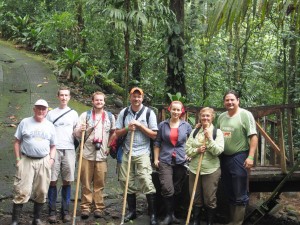
The MITS team includes (L to R) Dr. Shear, Dr. Paul Marek and grad student Jackson Means (Virginia Tech), Dr. Jason Bond and grad student Rebecca Godwin (Auburn), Dr. Petra Sierwald (Field Museum) and Carlos Viquez (INBio).
The picture below shows a species of Platydesmus, a common millipede under tree bark at La Selva. This is the only genus of millipedes known to show subsocial behavior. The young are brooded and cared for by the males.
We found the tarantula (Psalmopoeus sp.) below in a tube on a tree trunk.
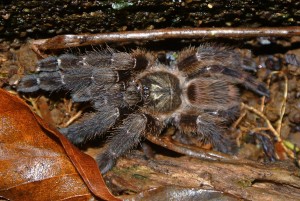 One of the biggest millipedes we captured was Nyssodesmus python, about four inches long and 3/4 inch wide. This species is found throughout Central America.
One of the biggest millipedes we captured was Nyssodesmus python, about four inches long and 3/4 inch wide. This species is found throughout Central America.
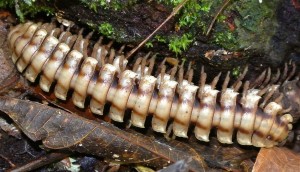 One of our goals was to get live material of the genus Epinannolene, since the defensive chemistry of the whole suborder has been worked out only for one species, which produces a molecule that is new to arthropods. As you can see below, we got plenty!
One of our goals was to get live material of the genus Epinannolene, since the defensive chemistry of the whole suborder has been worked out only for one species, which produces a molecule that is new to arthropods. As you can see below, we got plenty!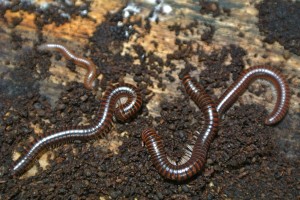
The picture below shows the Strawberry Poison Frog, very common at La Selva. The frogs are poisonous to touch, but do not produce their own poison. Instead, they eat ants that contain toxic alkaloids and transfer them to their skin. Frogs raised in captivity on other insects are not poisonous.
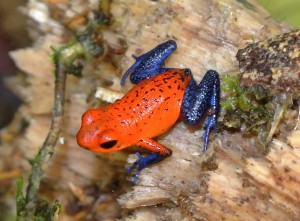 The trip was highly successful and sequencing is proceeding in the labs at Auburn. Oh, and jaguars did not really rip my flesh. That was just to get your attention.
The trip was highly successful and sequencing is proceeding in the labs at Auburn. Oh, and jaguars did not really rip my flesh. That was just to get your attention.
Professor Werth presents his whale research at the Smithsonian
H-SC Biology Professor Alex Werth recently returned from a June conference with colleagues from around the world, hosted by George Mason University and the Smithsonian Institution, on the evolution of whales and other marine life. He gave a talk on the evolution of filter feeding in whales–the focus of his current research. A highlight of the meeting was spending a day looking through the rare bones and rare books of the Smithsonian’s library collection in downtown DC and the osteological collection in suburban Maryland. There is not enough room for the whale bones to be kept at the National Museum of Natural History. The 7 meter long jaws of the blue whale are the largest individual bones that have ever been on Earth!
Professor Werth works with whales in Alaska
H-SC Biology professor Alex Werth spent the month of April working at the University of Alaska (UAS) Southeast and the Sitka Sound Science Center on a Scientist in Residence fellowship supported by the National Science Foundation. He got to see gray and humpback whales and loads of other marine life–the number of marine mammal species he has seen so far during his sabbatical year is up to twenty! He saw the most amazing humpback whale breach he has ever seen in decades at sea. He also worked with local high school students (teaching ten classes), judged a middle school science fair, gave a radio interview, did a science cafe, and gave Earth Day and other community science lectures, plus found time to work with UAS scientists on whale feeding.
Prof. Werth is eager to bring this knowledge back to Hampden-Sydney’s marine biology classes, and ideally to bring students up to Alaska so they can see marine mammals for themselves.
Four H-SC Sophomores Accepted into Medical School!
Recently, four Hampden-Sydney College sophomores were accepted into medical schools through the College’s Early Assurance Program Agreements with Virginia Commonwealth University (VCU) and George Washington University (GWU). Travis Goodloe and Jefferson Thompson were both accepted into VCU, and Evan Harris and Jake Farrar were both accepted at GWU. These rising juniors will complete their remaining two years at Hampden-Sydney and then have guaranteed acceptance into these medical school programs. Congratulations to our future doctors!!!

